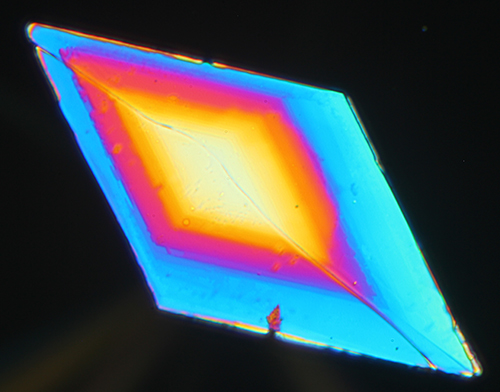
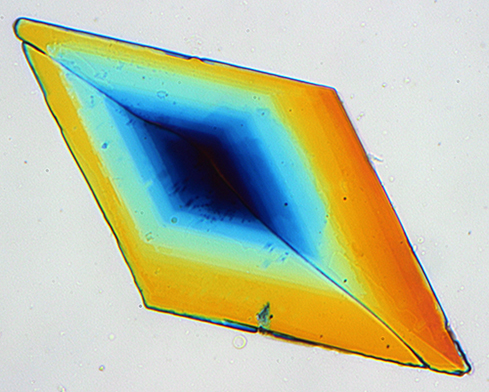
|
Uncrossing the polars - exploring parallel polars for qualitative crystal studies by David Walker,UK |
Like many microscopy enthusiasts I enjoy exploring prepared slides of crystals under crossed polarising filters, with or without adding a tint plate. I am currently reading John Delly's splendid recent book 'Essentials of Polarized Light Microscopy and Ancillary Techniques' (1). In Chapter 18 he discusses and illustrates the value of using parallel rather than crossed polarising filters for quantitative studies of birefringent materials. The colours seen are the complementary Newtonian colours and can be useful for distinguishing the orders of colours when it is unclear using crossed polars. Delly illustrated two examples of published Michel-Lévy charts that showed both the crossed and parallel colour spectrum. Quartz fragments are used as an example for using both crossed / parallel polars and also illustrates their use for conoscopy using both a uniaxial and biaxial specimen.
I don't recall being aware of this technique before although when I checked in a couple of books already owned (2,3) its value was briefly discussed but its possible potential I had overlooked for qualitative studies. So out of interest I explored my collection of 19th and 20th century prepared slides to compare the effect of using both crossed (XP) and parallel polars (PP). Some examples with comments are illustrated below.
For subjects set against a black background under XP such as isolated crystals, the background with PP changes to a shade of white. For many of my own crystal slides the complementary colours with PP were washed out and those that were more colourful needed some tonal balance adjustment to bring the colours out. So it is very much try PP and see as it may only take seconds to adjust the filter orientation, especially if like my set up the analyser sits on the field lens of my Zeiss Photomicroscope III.
The XP images are out of camera but the PP images benefited from tonal balance correction and the background auto colour corrected to white in Photoshop Elements.
Equipment used: Zeiss Photomicroscope III, Canon 600D DSLR body (APS-C sensor), projection eyepiece Zeiss 10X KpL W raised on a short collar to give a real image.


Above. Aspartic acid, Victorian papered slide, unnamed mounter. Zeiss 10/0.22 achromatic.
Left - crossed polars,right - parallel polars.
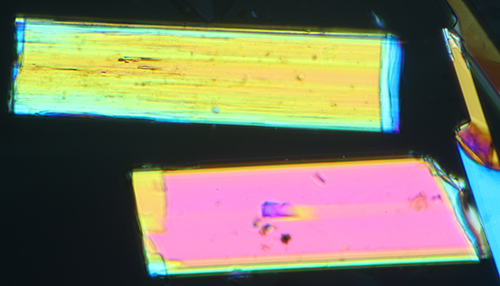
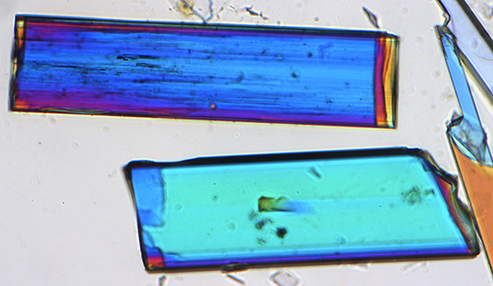
Above. Zeolite from basalt, Giants Causeway. Zeiss 10/0.22 achromatic.
Left - crossed polars, right - parallel polars
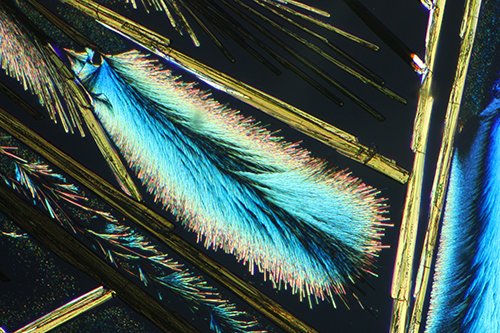
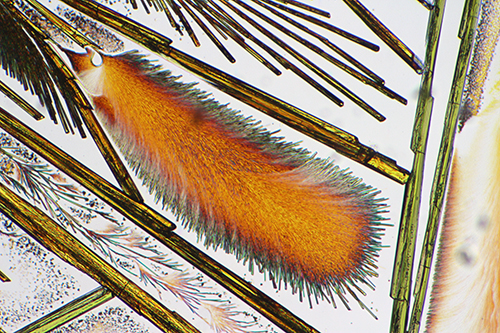
Above. Barium platinocyanide, 19th century slide, unnamed mounter. Zeiss 6.3/0.16 planachromatic.
Left - crossed polars,right - parallel polars
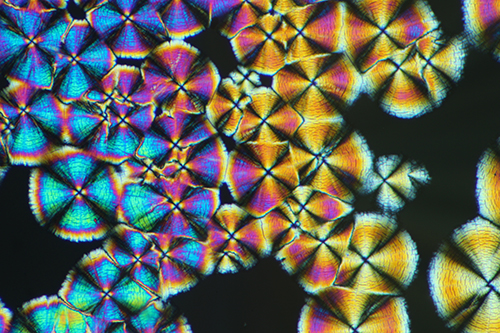
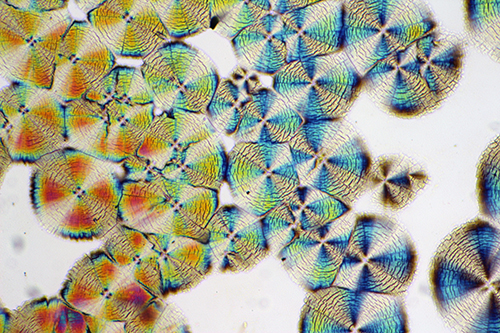
Quinate of quinine, 19th century slide, unnamed mounter. Zeiss 6.3/0.16 planachromatic.
Left - crossed polars,right - parallel polars
Crossed and parallel polars with and without a lambda tint plate. Tint plates can be tried as well with both orientations of the polarisers, an example is below.
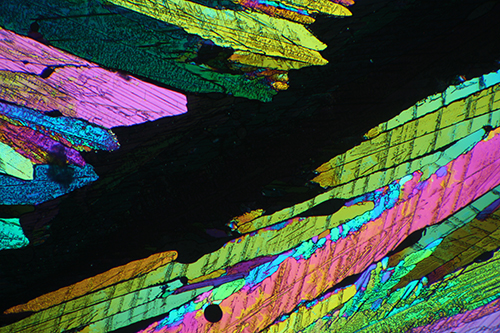
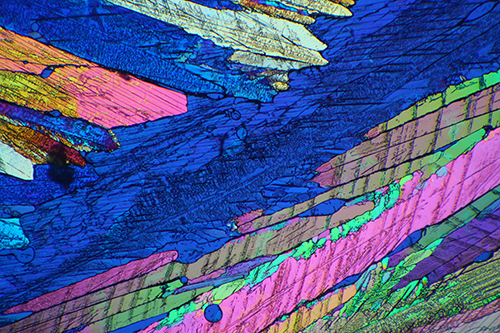
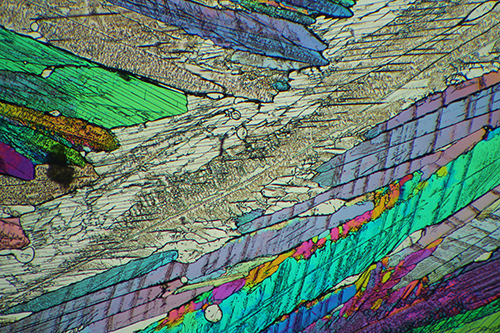
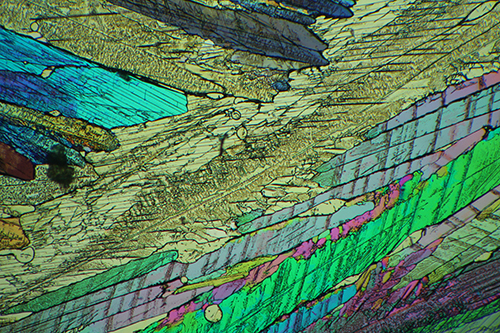
Above. Adipic acid, NBS slide. Zeiss 2.5/0.08 planachromatic.
Above left - crossed polars, above right - crossed polars with lambda tint plate.
Below left - parallel polars, below right - parallel polars with lambda tint plate.
Conoscopic images: An example of using XP and PP with biaxial muscovite mica is shown below, again the complementary Newtonian colours are seen using PP as described and illustrated by Delly (1).
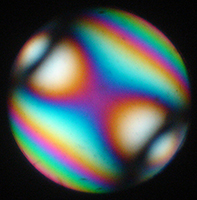
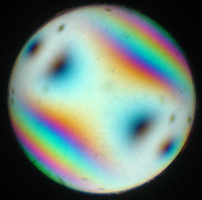
Conoscopic image of muscovite mica, i.e. image seen in back focal plane of the objective, left - XP, right - PP.
Vickers 40/0.85 objective.
The author David Walker welcomes any comments.
References
1) John Gustav Delly, 'Essentials of Polarized Light Microscopy and Ancillary Techniques', 2017, pub. Hooke College of Applied Science, USA, pp. 20, 146, 266, 270-273 (guided illustrated experiments), 277, 449 ('Parallel Polarizers' section, Chapter 18). This has been beyond my modest book budget new (typically £280 in the UK at time of writing) but now a few years after publication, copies are coming up on the used book market.
2) Walter C. McCrone, Lucy B. McCrone, John Gustav Delly, 'Polarized Light Microscopy', 1984 9th printing 1995, pub. McCrone Research Institute. pp. 145 and 167.
3) N. H. Hartshorne and A. Stuart, 'Crystals and the Polarising Microscope', pub. Edward Arnold Ltd, third edition 1960, pp. 275-276, fig. 200.
Published in the July 2020 edition of Micscape.
Please report any Web problems or offer general comments to the Micscape Editor .
Micscape is the on-line monthly magazine of the Microscopy UK web site at Microscopy-UK
© Onview.net
Ltd, Microscopy-UK, and all contributors 1995 onwards. All rights
reserved.
Main site is at www.microscopy-uk.org.uk
with full mirror at
www.microscopy-uk.net
.